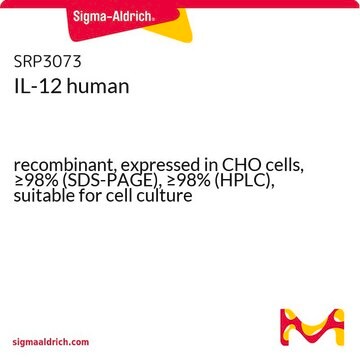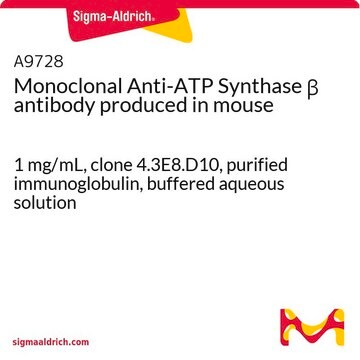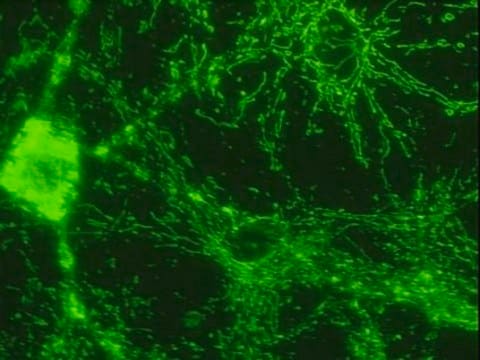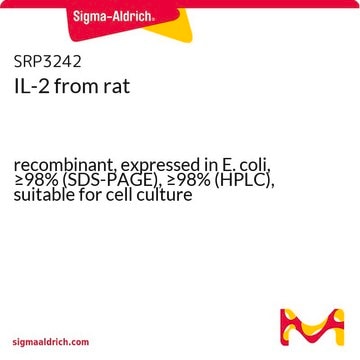MABS1304
Anti-ATP Synthase subunit β Antibody, clone 11/21-7-A8
clone 11/21-7-A8, from mouse
Sinonimo/i:
ATP synthase subunit beta, mitochondrial, ATP Synthase subunit β, beta-F1-ATPase
About This Item
Prodotti consigliati
Origine biologica
mouse
Livello qualitativo
Forma dell’anticorpo
purified immunoglobulin
Tipo di anticorpo
primary antibodies
Clone
11/21-7-A8, monoclonal
Reattività contro le specie
human, mouse, rat
tecniche
ELISA: suitable
dot blot: suitable
immunocytochemistry: suitable
western blot: suitable
Isotipo
IgG1κ
N° accesso NCBI
N° accesso UniProt
Condizioni di spedizione
wet ice
modifica post-traduzionali bersaglio
unmodified
Informazioni sul gene
human ... ATP5B(506)
Descrizione generale
Immunogeno
Applicazioni
ELISA Analysis: A representative lot detected His-tagged full-length human ATP Synthase subunit β (beta-F1-ATPase) recombinant protein by direct ELISA (Acebo, P., et al (2009). Transl Oncol. 2(3):138-145).
Dot Blot Analysis: A representative lot detected ATP Synthase subunit β (beta-F1-ATPase) by Dot blot using His-tagged full-length human beta-F1-ATPase recombinant protein or HepG2 lysate (Acebo, P., et al (2009). Transl Oncol. 2(3):138-145).
Western Blotting Analysis: A representative lot detected ATP Synthase subunit β (beta-F1-ATPase) in human hepatoma HepG2, murine hepatoma Hepa 1-6, and normal rat liver epithelial C9 (Clone 9) cells.
Western Blotting Analysis: A representative lot detected ATP Synthase subunit β (beta-F1-ATPase) expression in various cancer patients tissues (Acebo, P., et al (2009). Transl Oncol. 2(3):138-145).
Western Blotting Analysis: A representative lot detected ATP Synthase subunit β (beta-F1-ATPase) downregulation in HCT116 human colon cancer cells in response to AMPK pathway activation upon oligomycin or AICAR treatment (Martinez-Reyes, J., et al. (2012). Biochem J. 444(2):249-259).
Signaling
Developmental Signaling
Qualità
Western Blotting Analysis: 0.5 µg/mL of this antibody detected ATP Synthase subunit β in 10 µg of HepG2 cell lysate.
Descrizione del bersaglio
Stato fisico
Stoccaggio e stabilità
Altre note
Esclusione di responsabilità
Not finding the right product?
Try our Motore di ricerca dei prodotti.
Codice della classe di stoccaggio
12 - Non Combustible Liquids
Classe di pericolosità dell'acqua (WGK)
WGK 1
Punto d’infiammabilità (°F)
Not applicable
Punto d’infiammabilità (°C)
Not applicable
Certificati d'analisi (COA)
Cerca il Certificati d'analisi (COA) digitando il numero di lotto/batch corrispondente. I numeri di lotto o di batch sono stampati sull'etichetta dei prodotti dopo la parola ‘Lotto’ o ‘Batch’.
Possiedi già questo prodotto?
I documenti relativi ai prodotti acquistati recentemente sono disponibili nell’Archivio dei documenti.
Il team dei nostri ricercatori vanta grande esperienza in tutte le aree della ricerca quali Life Science, scienza dei materiali, sintesi chimica, cromatografia, discipline analitiche, ecc..
Contatta l'Assistenza Tecnica.








